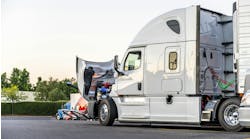There's been ample discussion on the subject of life-cycle costing over the years, and only the most uninformed fleet managers would consider buying their tires and wheels based solely on initial purchase price. A few bad decisions are made from time to time, but most result from poor internal communications or last minute wheeling and dealing to negotiate a lower truck price, with wheels and tires given only cursory consideration.
The cost saving advantages of retreading programs, and the necessary procurement of high quality new tire casings to support them, are pretty much taken for granted today. The problem, however, is that some fleet managers base the life-cycle costing of their tire programs solely on those numbers. But that's an over-simplified approach that could leave lots on the table in today's competitive business environment.
Here are some other factors that can add costs to a tire program if they're not addressed adequately:
Trade cycles
Restrictions on tire tread depths and conditions are becoming more common in trade package negotiations. Likewise, private used truck and trailer sales can be structured to either dispose of tires that no longer meet fleet guidelines, or to market the used vehicles with high tread tires and collect some premium for doing so.
Coordination is necessary so that the timing of purchases and sales ensures that the three basic objectives of tire asset management are met: buy only the tires you want; keep and maintain only the tires you want running in the fleet; and sell, at the maximum return, all tires that don't fit one of these categories. Objective management of your tire assets should include an accounting mechanism for debiting tires delivered on new equipment and crediting tires on traded or sold vehicles.
Over-the-road purchases
While the primary objective in these situations is to minimize downtime, buying only the brand and type of tire you want and at a competitive cost should be a close second. Many fleets record over-the-road purchases as expense items rather than as tire program costs. Also, record keeping should include the reason a tire had to be replaced, such as product deficiency, driver error or abuse, accident, or normal/unexplained failure or wear-out. Any tires replaced over-the-road that may be candidates for warranty consideration should be followed and credited as appropriate.
Retread programs
The pure cost of retreading your casings is typically negotiated to the nearest penny. Other costs, however, are often not defined and can vary considerably due to differences in judgment, tire brand/type preparation or repair requirements, and reject-and-return criteria.
Labor charges
Extraordinary tire-related labor charges can also get lost in the record-keeping shuffle. But they should be taken into consideration when making cost comparisons among brand or type. For example, if steer axle tires wear slowly and achieve high removal mileages, but must be switched side-to-side in mid-life to obtain the total wear potential, the costs may be justified but should be included as part of the total equation.
These are just some of the factors that should be included when determining the true cost of your tire program. One way to make sure you're not leaving anything out is to ask: “Who touches the tires from the time they're first received to the time they leave your fleet?” Providing a complete answer is simply a matter of thinking through your processes and practices.Taking the time to do this will enable you to develop a cost-analysis format that will lead to good management and even cost savings — in spite of your prices.


